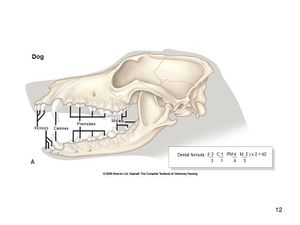Difference between revisions of "Dental Formula - Dog"
Fiorecastro (talk | contribs) |
|||
| (2 intermediate revisions by 2 users not shown) | |||
| Line 3: | Line 3: | ||
[[Image:Aspinall Slide12.JPG|thumb|right|300px|<small>Image from [http://www.elsevierhealth.co.uk/veterinary-nursing/spe-60136/ Aspinall, The Complete Textbook of Veterinary Nursing], Elsevier Health Sciences, ''All rights reserved''</small>]] | [[Image:Aspinall Slide12.JPG|thumb|right|300px|<small>Image from [http://www.elsevierhealth.co.uk/veterinary-nursing/spe-60136/ Aspinall, The Complete Textbook of Veterinary Nursing], Elsevier Health Sciences, ''All rights reserved''</small>]] | ||
| − | Dogs are toothless at birth. The '''deciduous''' teeth are complete and functional within 2 months of birth in most breeds. '''Permanent''' teeth are complete and | + | Dogs are toothless at birth. The '''deciduous''' teeth are complete and functional within 2 months of birth in most breeds. '''Permanent''' teeth are complete and funtional by the end of the 7th month. |
| Line 10: | Line 10: | ||
Formula for '''permanent''' teeth: 2 (I3/3 C1/1 P4/4 M2/3) | Formula for '''permanent''' teeth: 2 (I3/3 C1/1 P4/4 M2/3) | ||
| − | |||
| − | |||
| − | ===Canine Teeth=== | + | ====Canine Teeth==== |
| − | The canine teeth are large, curved and laterally compressed. Their [[Tooth - Anatomy & Physiology#Root|root]] is longer than their [[Tooth - Anatomy & Physiology#Crown|crown]]. They have a single [[Tooth - Anatomy & Physiology#Root|root]]. | + | The canine teeth are large, curved and laterally compressed. Their [[Tooth - Anatomy & Physiology#Root|root]] is longer than their [[Tooth - Anatomy & Physiology#Crown|crown]]. They have a single [[Tooth - Anatomy & Physiology#Root|root]]. They each have a single root. |
| − | ===Premolars=== | + | ====Incisors==== |
| + | Incisors have a single [[Tooth - Anatomy & Physiology#Root|root]]. | ||
| + | |||
| + | ====Premolars==== | ||
Premolars are irregular and closely-spaced. They are more complex and larger caudally. The first maxillary premolar has a single root, the second and third maxillary premolar have two roots and the fourth maxillary premolar (carnasial tooth) has three roots. | Premolars are irregular and closely-spaced. They are more complex and larger caudally. The first maxillary premolar has a single root, the second and third maxillary premolar have two roots and the fourth maxillary premolar (carnasial tooth) has three roots. | ||
| − | ===Molars=== | + | ====Molars==== |
The molars are broader than the premolars. The large flat surface is used for grinding. The maxillary molars have three roots each. | The molars are broader than the premolars. The large flat surface is used for grinding. The maxillary molars have three roots each. | ||
| Line 27: | Line 28: | ||
{{Template:Learning | {{Template:Learning | ||
| − | |||
|OVAM = [http://www.onlineveterinaryanatomy.net/content/canine-dentition Image - Canine Dentition] | |OVAM = [http://www.onlineveterinaryanatomy.net/content/canine-dentition Image - Canine Dentition] | ||
}} | }} | ||
| Line 36: | Line 36: | ||
{{Waltham}} | {{Waltham}} | ||
| − | + | ||
| − | + | {{OpenPages}} | |
[[Category:Teeth - Anatomy & Physiology]] | [[Category:Teeth - Anatomy & Physiology]] | ||
[[Category:Dog - Alimentary System]] | [[Category:Dog - Alimentary System]] | ||
Revision as of 18:49, 12 January 2015
Overview

Dogs are toothless at birth. The deciduous teeth are complete and functional within 2 months of birth in most breeds. Permanent teeth are complete and funtional by the end of the 7th month.
Formula for deciduous teeth: 2 (i3/3 c1/1 p3/3)
Formula for permanent teeth: 2 (I3/3 C1/1 P4/4 M2/3)
Canine Teeth
The canine teeth are large, curved and laterally compressed. Their root is longer than their crown. They have a single root. They each have a single root.
Incisors
Incisors have a single root.
Premolars
Premolars are irregular and closely-spaced. They are more complex and larger caudally. The first maxillary premolar has a single root, the second and third maxillary premolar have two roots and the fourth maxillary premolar (carnasial tooth) has three roots.
Molars
The molars are broader than the premolars. The large flat surface is used for grinding. The maxillary molars have three roots each.
Breed Differences
Eruption times differ between breeds so it is difficult to age dogs by their teeth.
| Dental Formula - Dog Learning Resources | |
|---|---|
Anatomy Museum Resources |
Image - Canine Dentition |
| This article was expert reviewed by Lisa Milella BVSc DipEVDC MRCVS. Date reviewed: 9 September 2014 |
| Endorsed by WALTHAM®, a leading authority in companion animal nutrition and wellbeing for over 50 years and the science institute for Mars Petcare. |
Error in widget FBRecommend: unable to write file /var/www/wikivet.net/extensions/Widgets/compiled_templates/wrt6954c4197b2655_17141835 Error in widget google+: unable to write file /var/www/wikivet.net/extensions/Widgets/compiled_templates/wrt6954c41984a7e0_48169672 Error in widget TwitterTweet: unable to write file /var/www/wikivet.net/extensions/Widgets/compiled_templates/wrt6954c4198c1190_12175751
|
| WikiVet® Introduction - Help WikiVet - Report a Problem |